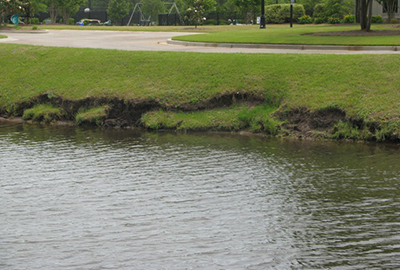Shorelines are home to a unique community of plants, because they are essentially narrow wetlands. Plants that thrive at the water's edge must be able to grow in soils that are permanently saturated and have to survive extended periods underwater. These limiting conditions prevent most of the typical landscape plants from growing well in this zone. As a result, the majority of plants that naturally grow at the water's edge are unfamiliar to most homeowners, and often acquire the label "weed". This is unfortunate because the benefits of cultivating these native plants largely outweigh the negatives, especially along the banks of stormwater ponds. Considering the benefits, it is recommended that wetland plants be protected around stormwater pond shorelines.
Shoreline plants help to:
- prevent erosion and stabilize the bank
- remove nutrients that contribute to algae growth
- filter debris and pollutants
- provide cover and forage for fish, frogs, and song birds
- shade the water
- baffle wind and wave energy
-
Is turf grass a good shoreline plant?
No. Turf grass is not a wetland plant, and it does not grow well at the water's edge. Turf does well on the top of the bank slope. Although turf grass will survive at the water's edge, its roots do not penetrate deep into saturated soils, and it is more prone to disease where it stays too moist. Over time, the shallow roots of turf will be undercut by erosion, and the bank will slump. Also, turf grass does very little to filter runoff and protect water quality. On the contrary, the fertilizers and pesticides used to keep turf healthy pose a significant threat to water quality and are not recommended on the bank slopes of stormwater ponds. Also, the repeated broadcasting of grass clippings into the water each time the bank is mowed will contribute nutrients to the water and exacerbate algae growth.

-
If turf doesn't work, what plants are recommended?
A variety of native wetland plants with deep, robust root systems are suited for pond shorelines. It is recommended that plants with a vertical growth habit be used rather than plants with a "creeping" or "trailing" growth habit to reduce the potential for spread into the pond and clogging pipes. Vertical shoreline plants are usually restricted to the shoreline because they typically cannot grow in water deeper than 12 inches and cannot spread up the bank beyond where the soils remain wet. There are a number of very attractive flowering plants that are quite easy to grow in this zone, including several irises, lilies, rushes, and other perennial flowing plants. For more information and a plant list, see the Shorescaping fact sheet.
-
Are there any plants that I should avoid along my shoreline?
Yes. The basin of a stormwater pond needs to be open and free of large obstructions. Trees and large shrubs should not be allowed to grow on the bank slope or at the water's edge because they can obstruct maintenance equipment and reduce storage capacity in the basin. Also, deciduous trees drop leaves each fall, which can accelerate sedimentation in the pond. As mentioned above, trailing plants that grow horizontally have the potential to grow large mats that extend over the water surface, impede flow and circulation, and can clog pipes and outfalls. It is not recommended that plants such as alligatorweed, waterprimrose, parrotfeather, or pennywort, which grow laterally over the water be allowed to form large mats that extend from the shore. Many homeowners find cattails to be undesirable because they grow tall, obstruct views, and spread rapidly. For this reason, you may choose to eliminate cattails; however, cattails provide excellent erosion control and absorb nutrients efficiently. Finally, there are several plants that grow in ponds that are considered illegal plants in South Carolina because they are invasive exotics that impair freshwater systems. Plants that are on the illegal plants list should never be introduced into stormwater ponds.
-
Will I attract snakes and other nuisance wildlife if I let wetland plants grow on my shoreline?
Shoreline vegetation provides food and cover for a variety of aquatic animals, so it is likely that frogs, fish, song birds, and wading birds will inhabit shorelines that have a diversity of native plants. It is difficult to make the shoreline suitable for these attractive animals without also attracting their predators, so a pond bank that has a large number of frogs and birds will occasionally attract a snake that feeds on those animals. However, this is of limited concern around stormwater ponds, because the shoreline plants form a very narrow band around the pond due to the steep slope of the bank. In the event that a snake is sighted, it should be viewed as a positive indication that the plants are functioning as intended and are minimizing pollution, stabilizing the bank, and providing cover for desirable animals. Finally, it must be noted that the vast majority of snakes in South Carolina are non-venomous. Shoreline plants may also help deter some nuisance wildlife. Ducks and geese find it difficult to traverse a shoreline with vertical emergent plants. Also, muskrats have a more difficult time digging burrows in well-vegetated pond banks. For more information visit the managing nuisance wildlife in stormwater ponds page.

